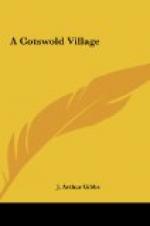A mosaic pavement, discovered here about 1811, was placed in the British Museum.
It is very sad to come upon these remote manor houses in all parts of the Cotswold district, and to find that their ancient glory is departed, even though their walls are as good as they were two hundred years ago, when the old squires lived their jovial lives, and those halls echoed the mirth and merriment which characterised the life of “the good old English gentleman, all of the olden time.”
Other fine old houses in this immediate district which have not been mentioned are Ampney Park, a Jacobean house containing an oak-panelled apartment, with magnificently carved ceiling and fine stone fireplace; Barnsley and Sherborne, partly built by Inigo Jones; Missarden, Duntisborne Abbots, Kemble, and Barrington. Rendcombe is a modern house of some size, built rather with a view to internal comfort than external grace and symmetry.
[Illustration: Village cricketers 242.png]
CHAPTER XI.
COTSWOLD PASTIMES.
It is not surprising that in those countries which abound in sunshine and fresh, health-giving air, the inhabitants will invariably be found to be not only keen sportsmen, but also accomplished experts in all the games and pastimes for which England has long been famous. Given good health and plenty of work mankind cannot help being cheerful and sociably inclined; for this reason we have christened the district of which we write the “Merrie Cotswolds.” From time immemorial the country people have delighted in sports and manly exercises. On the north wall of the nave in Cirencester Church is a representation of the ancient custom of Whitsun ale. The Whitsuntide sports were always a great speciality on Cotswold, and continue to the present day, though in a somewhat modified form.
The custom portrayed in the church of Cirencester was as follows:—
The villagers would assemble together in one of the beautiful old barns which are so plentiful in every hamlet. Two of them, a boy and a girl, were then chosen out and appointed Lord and Lady of the Yule. These are depicted on the church wall; and round about them, dressed in their proper garb, are pages and jesters, standard-bearer, purse-bearer, mace-bearer, and a numerous company of dancers.
The reason that a representation of this very secular custom is seen in the church probably arises from the fact that the Church ales were feasts instituted for the purpose of raising money for the repair of the church. The churchwardens would receive presents of malt from the farmers and squires around; they sold the beer they brewed from it to the villagers, who were obliged to attend or else pay a fine.
The church house—a building still to be seen in many villages—was usually the scene of the festivities.




